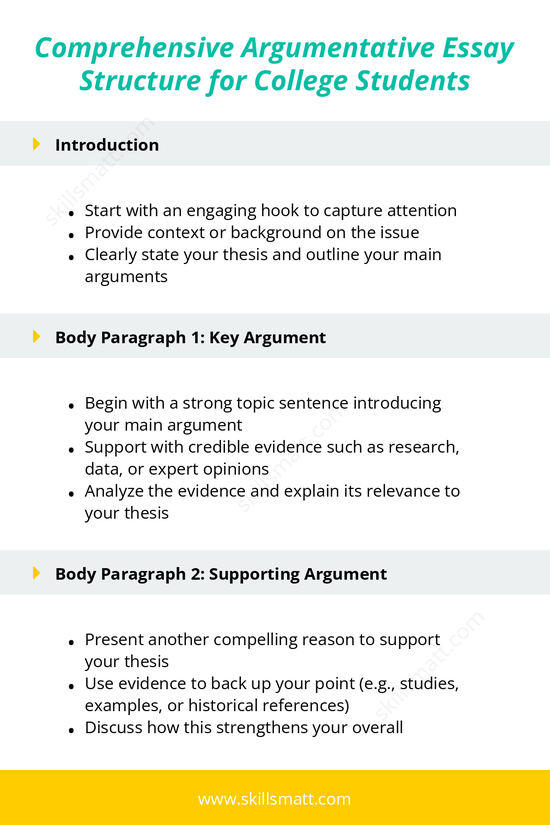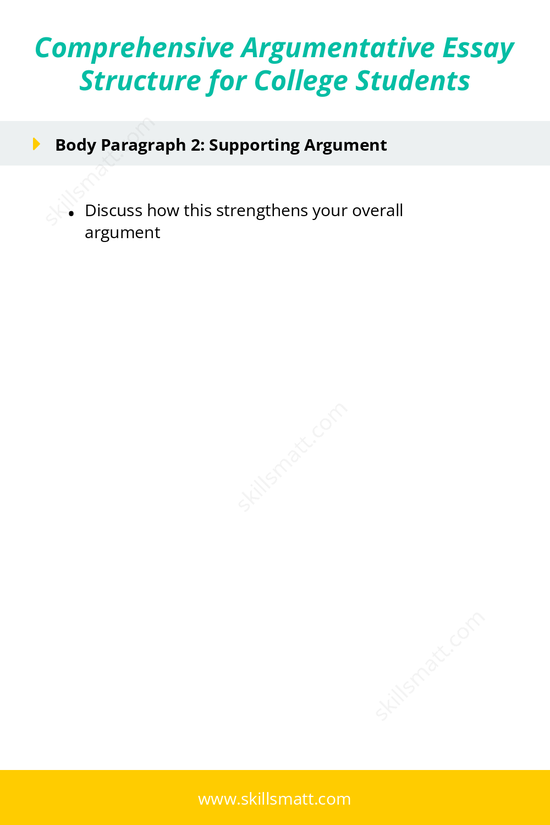Argumentative essays are a staple of college coursework. They allow students to delve deeply into a topic, express their viewpoints, and demonstrate their ability to research and argue effectively. The structure of an argumentative essay is crucial for presenting your argument in a logical and convincing manner. Below, we provide a comprehensive outline for writing an argumentative essay that will help college students craft a well-organized, persuasive paper.
Introduction
The introduction is your first chance to hook the reader and make a strong case for why your argument is worth exploring. A strong introduction sets the tone for the rest of the essay and lays the groundwork for your thesis.
- Start with an engaging hook: Begin with an attention-grabbing hook that piques the reader’s interest. You could use a surprising fact, a relevant quote, or a thought-provoking question to draw the reader in.
- Provide context or background on the issue: After the hook, provide some background information that helps the reader understand the issue you will be discussing. This might include historical context, current events, or key terms related to the topic.
- Clearly state your thesis: The thesis is the central argument of your essay. Make sure to state it clearly and concisely. This statement should outline the main arguments that you will present in the body of your essay.
Body Paragraph 1: Key Argument
The first body paragraph presents the most important argument in support of your thesis. It should be the most convincing and impactful argument that lays the foundation for the rest of your essay.
- Begin with a strong topic sentence: The topic sentence should introduce the main point of the paragraph. It should be clear and direct, telling the reader what the paragraph will discuss.
- Support with credible evidence: Use evidence such as research studies, statistical data, or expert opinions to support your argument. Ensure that the evidence is credible and relevant to the point you are making.
- Analyze the evidence: After presenting the evidence, analyze it to show how it supports your thesis. Explain why this evidence is significant and how it strengthens your argument.
Body Paragraph 2: Supporting Argument
The second body paragraph provides additional support for your thesis. It should introduce another reason or piece of evidence that reinforces your argument.
- Present another compelling reason: Introduce a second strong argument that supports your thesis. This should be a logical extension of your first argument and provide more depth to your overall case.
- Use evidence to back up your point: Support this argument with evidence. You can draw from studies, examples, historical references, or other credible sources.
- Discuss how this strengthens your argument: Explain how this new evidence bolsters your case and how it fits within the larger context of your argument.
Body Paragraph 3: Address Counterarguments
One of the most important parts of a strong argumentative essay is addressing counterarguments. This demonstrates that you’ve thought critically about the issue and are prepared to defend your position against opposing views.
- Introduce potential counterarguments: Acknowledge opposing viewpoints that challenge your thesis. This shows that you’re aware of other perspectives and allows you to engage with the complexity of the issue.
- Refute these points: After presenting counterarguments, use logic and evidence to refute them. Show why the opposing views are less compelling or flawed, and explain how they don’t undermine your thesis.
- Demonstrate why your argument remains stronger: After refuting counterarguments, reaffirm the strength of your position. Make it clear why your thesis is still the best solution or explanation for the issue.
Conclusion
The conclusion is where you wrap up your essay and leave the reader with a lasting impression. It should restate your thesis, summarize your main arguments, and leave the reader with something to think about.
- Restate your thesis: In a new way, restate your thesis to remind the reader of your central argument. This reinforces the main point of the essay.
- Summarize key arguments and evidence: Briefly summarize the most important points and evidence you’ve presented. This helps the reader recall the strength of your argument and the evidence that supports it.
- Leave readers with a thought-provoking statement or call to action: End with a powerful thought or call to action. This could be a reflection on the broader implications of the issue or a suggestion for further research or action.
Writing a comprehensive argumentative essay requires careful planning, thoughtful analysis, and a well-structured approach. By following this outline, college students can craft essays that not only present strong arguments but also engage readers and leave a lasting impact. Remember to always support your claims with credible evidence, address counterarguments, and conclude with a powerful message that resonates with your audience.


